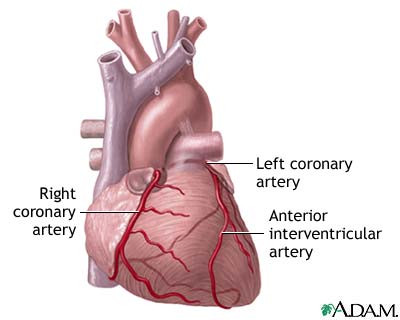Coronary Arteries - definition and function

Coronary Arteries are the network of arteries that encircles the HEART to provide its BLOOD supply. The two primary coronary arteries, the right coronary ARTERY and the left coronary artery, branch from the AORTA as it arises from the left ventricle. The left coronary artery is significantly larger and supplies the left heart. It drops along the left atrium, branching at the base of the left ventricle into the left anterior descending (LAD) and circumflex arteries. The circumflex artery wraps behind the heart, further branching into smaller arteries that trail across the left ventricle. The right coronary artery traverses the right atrium, nourishing the upper right heart. Numerous smaller arteries branch from it, the largest of which is the right marginal artery. The arterial network intertwines across the front of the heart in a network called Vieussens’s ring, which is similar in structure and purpose to the CIRCLE OF WILLIS at the base of the BRAIN. The precise pattern of the coronary arteries is unique for each person, however.
The coronary arteries deliver the largest volume of blood to the heart during diastole, the trough phase of the CARDIAC CYCLE during which the ventricles fill with blood, pulling blood from the aortic root as systole draws to a close. About 60 percent of the ventricular ejection goes to the coronary arteries. During systole, the peak of the cardiac cycle during which the ventricles pump blood out, the dynamic forces of the heart’s contraction cause the coronary arteries to constrict.
Coronary Arteries and Circulatory Structures
The extensive branching of the coronary arteries provides a fairly substantial level of redundancy for supplying the heart with blood. Even if damage or occlusion blocks one branch or several branches, other arterial branches can deliver blood to the same or nearby areas to cover the deficit. As well, the heart tends to develop collateral circulation in response to arterial damage, a self-repair feature in which new small arteries sprout to extend around the area of damage. These mechanisms can sustain adequate myocardial perfusion (distribution of blood throughout the heart MUSCLE) for a considerable time, even in the face of significant damage to the heart’s circulatory structures. As occlusion of the coronary arteries progresses, the collateral circulation of Vieussens’s ring extends.
Coronary Arteries and Restricted Blood Flow
The efficiency of coronary circulation is such that symptoms of oxygen deficiency (notably ANGINA PECTORIS and shortness of breath with exertion) do not become apparent until damage to the coronary arteries drops blood flow to about 30 percent of normal. At this point a cardiologist may recommend ANGIOPLASTY with STENT placement. The standard diagnostic point for the more invasive CORONARY ARTERY BYPASS GRAFT (CABG) is 90 percent or greater occlusion. The symptoms of restricted blood flow become most apparent when occlusion affects the larger branches of the coronary arteries, notably the LAD and circumflex. The primary conditions that affect the coronary arteries are ATHEROSCLEROSIS, called CORONARY ARTERY DISEASE (CAD) when it involves the coronary arteries, and coronary artery spasm, which often results from CAD though may have other causes.
For further discussion of the coronary arteries within the context of cardiovascular structure and function, please see the overview section “The Cardiovascular System.”
See also COCAINE; HEART ATTACK; LIFESTYLE AND CARDIOVASCULAR HEALTH.
Open discussion on the topic Coronary Arteries - definition and function
Similar interests
- Nuovi Casino
- Casinos Not On Gamstop
- UK Casinos Not On Gamstop
- Casinos Not On Gamstop
- UK Casinos Not On Gamstop
- Casino Non Aams Italia
- Slot Sites Not On Gamstop
- Meilleur Casino En Ligne
- Non Gamstop Casino Sites UK
- Meilleur Casino En Ligne
- Casino En Ligne France
- Best Non Gamstop Casinos
- Casinos Not On Gamstop
- UK Casino Not On Gamstop
- Casinos Not Signed Up To Gamstop
- Best Slot Sites UK
- Non Gamstop Casino Sites UK
- Online Casinos Nederland
- Online Casinos Nederland
- Casinos Not On Gamstop
- Best New Uk Casinos Not On Gamstop